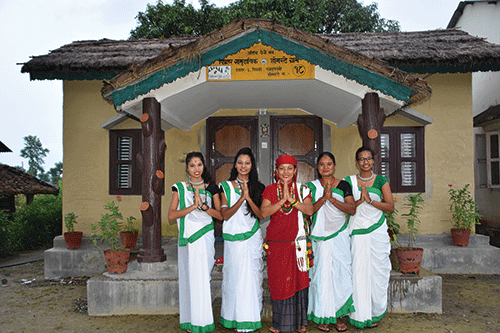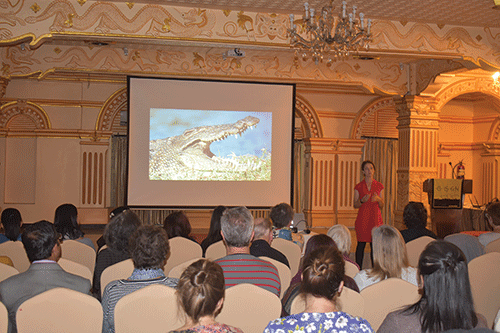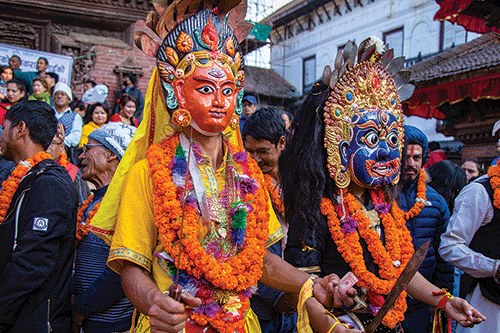A walk down memory lane with Nepal’s pioneering hoteliers provides a peek into the early days of Nepal’s hospitality industry.
We are greeted by a brown Alsatian rushing down the stairs. Mr. Hanson walks out after and introduces himself extending both hands and we get right onto the topic. “My step father opened the first hotel in Nepal, a hotel for tourists and such. I was six then”, he starts as we move into his living room.
 “Candles gave brighter illumination than electricity at the time. We had to use transformers to increase the brightness in rooms. There would be one tourist coming in about a month.” Pausing for a moment, he asks, “What was it though that you are writing about?” I cannot help a smile, “This, exactly”.
“Candles gave brighter illumination than electricity at the time. We had to use transformers to increase the brightness in rooms. There would be one tourist coming in about a month.” Pausing for a moment, he asks, “What was it though that you are writing about?” I cannot help a smile, “This, exactly”.
In the early 50’s, a Mr. Tom Mendes landed in Nepal with his friends to travel and sightsee. He saw that it was a nice place with a great view of mountains. In 1954, upon the guarantee of his pilot friends he opened Hotel Snow View, widely claimed to be Nepal’s first hotel. The hotel however, didn’t house a guest for the first six months. “Being a Christian, Mr. Mendes prayed. He said, ‘Lord if we do not get a guest now, we will have to close down the hotel. Exactly on that day, two travelers had walked from Darjeeling to Kathmandu checked in.
Mr. Mendes took it as a sign and the hotel was kept running,” says Hanson. Snow View was host to some of the earliest tourists visiting Nepal, including dignitaries, and a party for Queen Elizabeth. He shows me faded black and white pictures of the hotel located at the same spot in Lazimpat where the Mahaguthi building stands today. In its brochures, the Snow View Hotel advertised itself as “your home away from home”. It listed among its facilities single and double rooms with private bathrooms, private car touring trips and moderate rates, which came to about IRs. 100. The brochure also announced in bold letters: Meet the fascinating people of Nepal.
 “This is how we publicized the hotel back then”, he says handing me a paper-thin postcard printed in Calcutta, with a color sketch of the hotel and tourists lounging around. The market was composed of the occasional European and primarily pilots from Indian Airlines who wanted good accommodations.
“This is how we publicized the hotel back then”, he says handing me a paper-thin postcard printed in Calcutta, with a color sketch of the hotel and tourists lounging around. The market was composed of the occasional European and primarily pilots from Indian Airlines who wanted good accommodations.
“Let’s not talk about the past. More than what was it like then, it is more interesting to talk about what tourism is like today and what shape it will take in the future, isn’t it? Why are we so stuck in the past?” Karna Shakya is sitting on a chair, relaxed as he says this. When persisted, he gives short, astute answers. At one point, when asked what difference in terms of interests, nationalities and such he finds between the tourists coming in then and now, he says he has no idea. “I am not in the tourism business right now. It’s been quite some time since I have not looked into the operations of Kathmandu Guest House”.
 “You see tourism is not a business. It is a science of understanding human psychology. It’s a culmination of the studies of sociology, economy and conservation. It is ever changing and constant. When we look into the past of our tourism, we focus on the hippie era of the 60’s. That is also not wrong. In the 70’s, it morphed into adventure and nature tourism, which was the idea behind opening KGH. It was to open up Thamel, where at the time foxes would cry out into the night. Today we are into trekking and cultural tourism. I believe the future lies in adventure sports and in the balance of conservation and tourism. How much has it changed? Did we have any idea before that the tourists who came to Nepal and went back after going to Pashupati and Swayambhu would someday be jumping off of Sarangkot hill on a paraglider?”
“You see tourism is not a business. It is a science of understanding human psychology. It’s a culmination of the studies of sociology, economy and conservation. It is ever changing and constant. When we look into the past of our tourism, we focus on the hippie era of the 60’s. That is also not wrong. In the 70’s, it morphed into adventure and nature tourism, which was the idea behind opening KGH. It was to open up Thamel, where at the time foxes would cry out into the night. Today we are into trekking and cultural tourism. I believe the future lies in adventure sports and in the balance of conservation and tourism. How much has it changed? Did we have any idea before that the tourists who came to Nepal and went back after going to Pashupati and Swayambhu would someday be jumping off of Sarangkot hill on a paraglider?”
Maybe not. Mr. Hanson tells me that even until 1966 when he opened a branch of his hotel in Pokhara, the people in Kathmandu would not recommend Pokhara. “What is there in Pokhara – people would question. There was no electricity, no vehicles. I had to take a local person as a guide and find out places to sightsee. There weren’t many tourists either. They really started coming after 1974”.
 “Dwarika’s was opened in nineteen seventy…” I stall, confused about the exact date. “Sixty nine,” Mrs. Ambika Shrestha, the proprietor corrects me, “No, seventy seven,” she adds, remembering.
“Dwarika’s was opened in nineteen seventy…” I stall, confused about the exact date. “Sixty nine,” Mrs. Ambika Shrestha, the proprietor corrects me, “No, seventy seven,” she adds, remembering.
“What was the scene like before that?” I ask, prodding her to go back in time. “See, even before that, my husband had started the first hotel in Nepal in 1950, Hotel Paras. We had Indian tourists, as well as Japanese and pilots from the Indian Airlines. Dwarika’s was started in 1972 but we registered in 1977. Regarding hotels at the time, there was the Royal Hotel, Coronation and in Lazimpat, Hotel Snow View, run by Mendes.”
 I ask her how Dwarika’s came to be. “In 1972, during the coronation of King Birendra, all the rooms were booked by royalty. We had a travel company then and had guests coming in. Where would we put those guests?” She points at the different blocks of the current hotel and introduces them. “We had five rooms in all; there was a cowshed in there which was turned into two rooms later on, we made do with whatever we had. In time, with the favorable response of guests, we left the place, added ten rooms here and registered as a hotel. We kept adding onto it and built that block between ’81 and ’91”.
I ask her how Dwarika’s came to be. “In 1972, during the coronation of King Birendra, all the rooms were booked by royalty. We had a travel company then and had guests coming in. Where would we put those guests?” She points at the different blocks of the current hotel and introduces them. “We had five rooms in all; there was a cowshed in there which was turned into two rooms later on, we made do with whatever we had. In time, with the favorable response of guests, we left the place, added ten rooms here and registered as a hotel. We kept adding onto it and built that block between ’81 and ’91”.
Dwarika’s is popular for its traditional décor and woodwork, I mentioned. “Yes, our aim has always been to conserve old architecture by incorporating it here. My husband would collect old craft windows, some of it already rotting. It’d be brought here and trainees of master artisans would repair them. So much of the woodwork we have used in the hotel today is restored items.” What she remembers from those days comes up: “People would gather to see foreigners, but they didn’t ask for anything back then. They were just curious about the blue eyed, blonde haired people,” she says, smiling.
Over the years, of course, we have grown accustomed to the blue eyed, blonde haired people as the market has grown in leaps and bounds. In 1979, when Shyam Bahadur Pandey started Hotel Shangri-la, there were more tourists coming in from countries like America, Japan, France and Germany and the business registered a modest but predictable growth of about ten percent. However, even in the 70’s, opening a hotel was not easy. “It was very difficult to get the license, you needed a highly placed source. If you had that, it was still difficult to get the construction materials to actually build the hotel. During my early days of opening Shangri-la, I would always be busy running around trying to get hold of the bricks, rod, cement and so on. One even needed to be well connected to get a loan,” he recounts.
 Why then did he get involved in tourism at the first place, I ask him. “Well, before Shangri-la, I was in government service,” he replies. Having worked in countless ministries and commissions after his graduation, he didn’t picture himself in the same line. He was attracted to tourism because of one, its economic potential - he saw that Hotel Soaltee was full almost always, and two, because of the prestige attached to the line of work. “At that time, royalty was involved in the hotel business. Having worked in government service, I think, one gets a little image-conscious. I had a feeling that things would work out in the tourism business”.
Why then did he get involved in tourism at the first place, I ask him. “Well, before Shangri-la, I was in government service,” he replies. Having worked in countless ministries and commissions after his graduation, he didn’t picture himself in the same line. He was attracted to tourism because of one, its economic potential - he saw that Hotel Soaltee was full almost always, and two, because of the prestige attached to the line of work. “At that time, royalty was involved in the hotel business. Having worked in government service, I think, one gets a little image-conscious. I had a feeling that things would work out in the tourism business”.
It does seem like it has. Shangri-la today is a boutique hotel and although it has not expanded itself much in terms of physical space, it has changed over the years in its concept. “At the start it was just a hotel. After many consultations, it acquired a vision to brand it as a tourist-friendly hotel.”
Inside the smart interiors of Hotel Soaltee, I am ushered down a richly carpeted corridor into the private office of Prabhakar Rana. Although the concept of the hotel was thought of by prince Himalaya and Rana’s sister princess Princep, Rana was a part of the team right from the beginning, starting as a Purchase and Personnel Manager at a salary of NRs.300 and working his way to the top.
Under soft lighting, with a regal air to his stature, Rana regaled me with tales from his memories from before opening the doors of the hotel in November 25, 1966. “I have always given full credit to Boris for opening up tourism in Nepal, for convincing the then royalty about its advantages. He certainly was the father of tourism in Nepal but not so much of the hotel industry. Once there were people, the need for a world-class hotel was felt. This is where Nepal Industrial Development Corporation - backed by USAID in Nepal - came into the picture, which provided concessional loans to private companies, including us. When I come back after completing my studies, progress on the hotel had moved forward. The hotel was open, but a lot was in chaos. No one in expertise in hotels was around, so the idea to join hands with an international chain came up.”
With just 90 rooms then, the Hilton and Intercontinental chain did not fit the bill. It was then that the Oberoi group showed interest in the endeavor. Rana’s personal friendship came in handy. The Oberoi group was so enthusiastic and hands on about their first hotel outside their native India, that Rai Bahadur Oberoi himself spent 3 months here, supervising every small detail of the hotel. Rana himself benefitted immensely from this, as he had studied history in college and had no formal training at running a five star hotel. Soon there were many additions and renovations to the country’s first five star hotel, the most prominent of which was the addition of seven identical presidential suites that were built to accommodate the heads of state for the SAARC summit. Famous guests include Princess Diana and Queen Elizabeth II besides numerous heads of state and celebrities.
With world class services and a valley that is brimming with culture and traditions, most hotels did and are doing well. However, the hotel industry as rightly pointed out by Karna Shakya is not all business. In times of political turmoil and economic stride, what has kept these hotels and tourism in Nepal going? Karna Shakya thinks Nepal’s tourism is based on mystique and argues, “I am opposed to the opening up of virgin mountains for trekking and climbing. Why can’t we show tourists those mountains from a hill afar and tell them, ‘See that is a mountain that has never been trampled by humans?’”
Prabhakar Rana’s take on the subject differs. “We have training programs that have produced some really good managers. A lot of them have gone on to work for other great hotels, some in Kathmandu itself. But when a guest returns after ten years and is greeted like an old friend by a member of the hotel staff at my hotel, it does not have anything to do with our training and his education. I believe Nepal’s appeal for tourists is based on this friendly demeanor and genuine sense of hospitality.” This aspect of the country’s hotel industry, unlike the hotels and their world-class services is exclusive to the country.
The history of the hotel industry in Nepal dates back a couple of decades with a handful of pioneers who really opened up the country to many, many opportunities. Tourism today is still one of the major contributors to the state’s coffers. But the history of hospitality in Nepal, dates back several hundred years and several hundred people, to a time when there were no international visitors and certainly no need for any hotels. It was borne not because of necessity but due to the Nepali people’s culture, traditions and collective belief in an adage borrowed from a Hindu scripture, the Taittiriya Upanishad: ‘Athiti Devo Bhavah’ – the guest is god.










